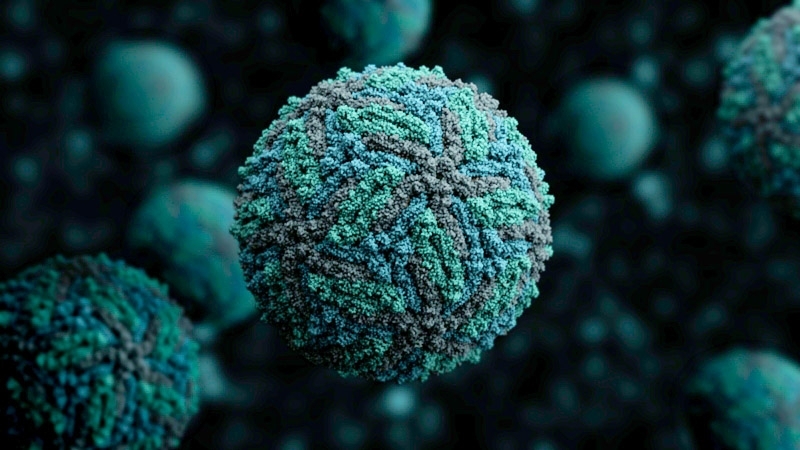

Discovery paves the way for developing strategies designed to block viral replication in the vector mosquito and prevent transmission to humans (image: three-dimensional representation of Zika virus / Wikimedia Commons)
Discovery paves the way for developing strategies designed to block viral replication in the vector mosquito and prevent transmission to humans.
Discovery paves the way for developing strategies designed to block viral replication in the vector mosquito and prevent transmission to humans.

Discovery paves the way for developing strategies designed to block viral replication in the vector mosquito and prevent transmission to humans (image: three-dimensional representation of Zika virus / Wikimedia Commons)
By Karina Toledo | Agência FAPESP – A study by Brazilian researchers published in the journal PLoS One has identified 13 lipids found in Aedes spp. mosquitoes as potential biomarkers for Zika virus infection.
The research was conducted with FAPESP’s support under the aegis of the São Paulo Zika Virus Research Network (Rede Zika). According to the authors, the discovery paves the way for the development of strategies designed to block infection in the insect vector, thereby interrupting transmission to humans.
“These molecules are important for the virus to enter cells and replicate, so they’re potential therapeutic targets. Previous studies showed that there are molecules that participate in viral infection in mosquitoes and are also found in humans,” said Rodrigo Ramos Catharino, a professor at the University of Campinas’s School of Pharmaceutical Sciences (FCF-UNICAMP) and head of its Innovare Biomarker Laboratory.
Most of the work was done during Carlos Fernando Melo’s research for his master’s degree, supervised by Catharino and with the collaboration of Jayme Souza-Neto, a researcher affiliated with São Paulo State University (UNESP) at Botucatu. José Luiz Proença Modena and Clarice Weis Arns, researchers at UNICAMP’s Biology Institute, also took part. All five are members of Rede Zika.
The group infected a cell line derived from larvae of Aedes albopictus, a relative of A. aegypti and also a vector of arboviruses, with the Brazilian strain of Zika isolated by researchers at Evandro Chagas Institute, Pará State, from a patient in Ceará State in northeastern Brazil. The results were compared with those for uninfected control cells.
“It was already known that when dengue virus infects cells in the insect, the expression of certain lipids increases. We decided to investigate whether this also happens in the case of Zika,” Melo said.
Cells were cultured on special glass slides so that they could later be transported for analysis using equipment such as a mass spectrometer. About five days after one of the cultures was inoculated with Zika, morphological alterations confirming the infection’s progress could already be seen under the microscope.
“The infected cells clustered together, forming clumps, whereas the uninfected control cells resembled a smooth carpet. Given this demonstration that the virus had infected the cells, we began analyzing their lipidome, or lipid profile,” Melo said.
Using mass spectrometry techniques, the researchers identified all the lipids expressed in the two cell lines, and with statistical analysis and imaging, they were able to identify 13 lipids whose expression in the infected cells increased to as much as twice the level in the control (see table below).

“Some of these molecules help the virus enter cells: this is the case, for example, for the classes phosphatidylserine (PS) and phosphatidylethanolamine (PE). Molecules in the class phosphatidylcholine (PC) assist viral replication directly, as they’re part of the vacuole that forms inside the cell for the pathogen to reproduce. If we can find ways to block these lipids, in principle, we’ll be able to stop the infection from progressing,” Melo said.
They also identified the molecule sphingofungin F, which is thought to be linked to a cellular immune response against the pathogen. “Previous studies suggest that this lipid acts to block viral replication inside the cell. In this case, therefore, it would be worth developing strategies to increase its concentration in infected cells,” Melo said.
Several possibilities for intervention are suggested by this new information, he added. One example would be to invest in environmental approaches, such as having the mosquito come into contact with exogenous molecules of sphingofungin F, as is done today with insecticides.
Another strategy would be to develop a transgenic mosquito in which the expression of some of these lipids would be suppressed or increased, depending on the case.
Next steps
According to Catharino, during Melo’s PhD research, Aedes spp. mosquitoes will be inoculated with Zika in the lab in an experiment designed to find out whether the same group of lipids is altered by infection in vivo.
“We’ll also work on strategies for diagnosing Zika,” he said. “We already have a method that’s practically ready, using mass spectrometry to identify metabolites present in blood or urine. We plan to make this test more powerful so it can identify infection by other arboviruses. In addition, a number of metabolomics studies will be performed in patients with Zika.”
The recently published study was supported by FAPESP via a Thematic Project coordinated by Aníbal Eugênio Vercesi, a professor at UNICAMP’s Medical School (FCM), as well as a regular research grant coordinated by Catharino, a Young Investigator grant coordinated by Souza-Neto, and PhD scholarships awarded to Cibele Zanardi Esteves and Diogo Noin de Oliveira, all of whom are co-authors of the article published in PLoS One.
The article “A lipidomics approach in the characterization of Zika-infected mosquito cells: potential targets for breaking the transmission cycle” (doi: 10.1371/journal.pone.0164377) can be read at journals.plos.org/plosone/article?id=10.1371/journal.pone.0164377.
Republish
The Agency FAPESP licenses news via Creative Commons (CC-BY-NC-ND) so that they can be republished free of charge and in a simple way by other digital or printed vehicles. Agência FAPESP must be credited as the source of the content being republished and the name of the reporter (if any) must be attributed. Using the HMTL button below allows compliance with these rules, detailed in Digital Republishing Policy FAPESP.





